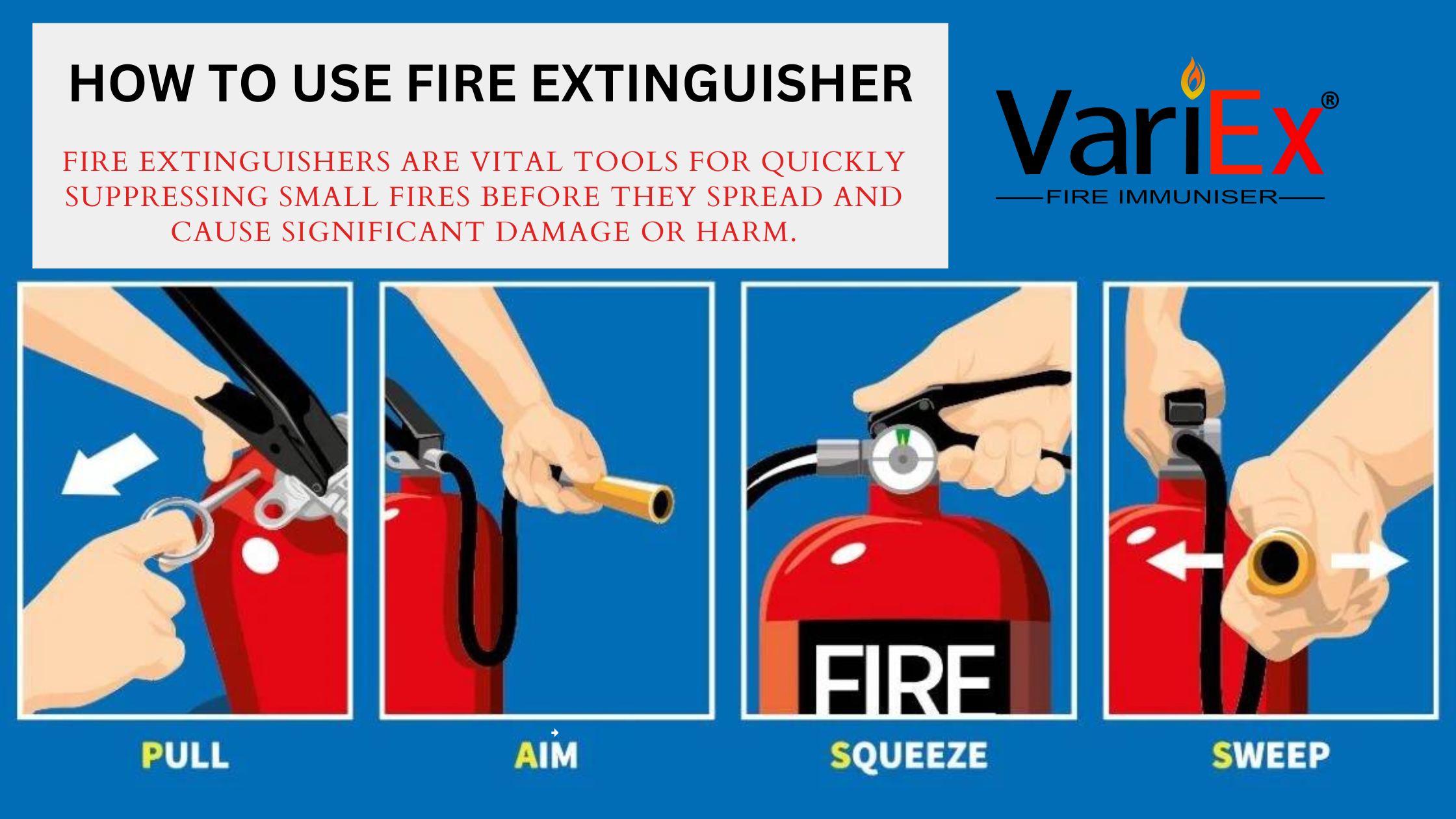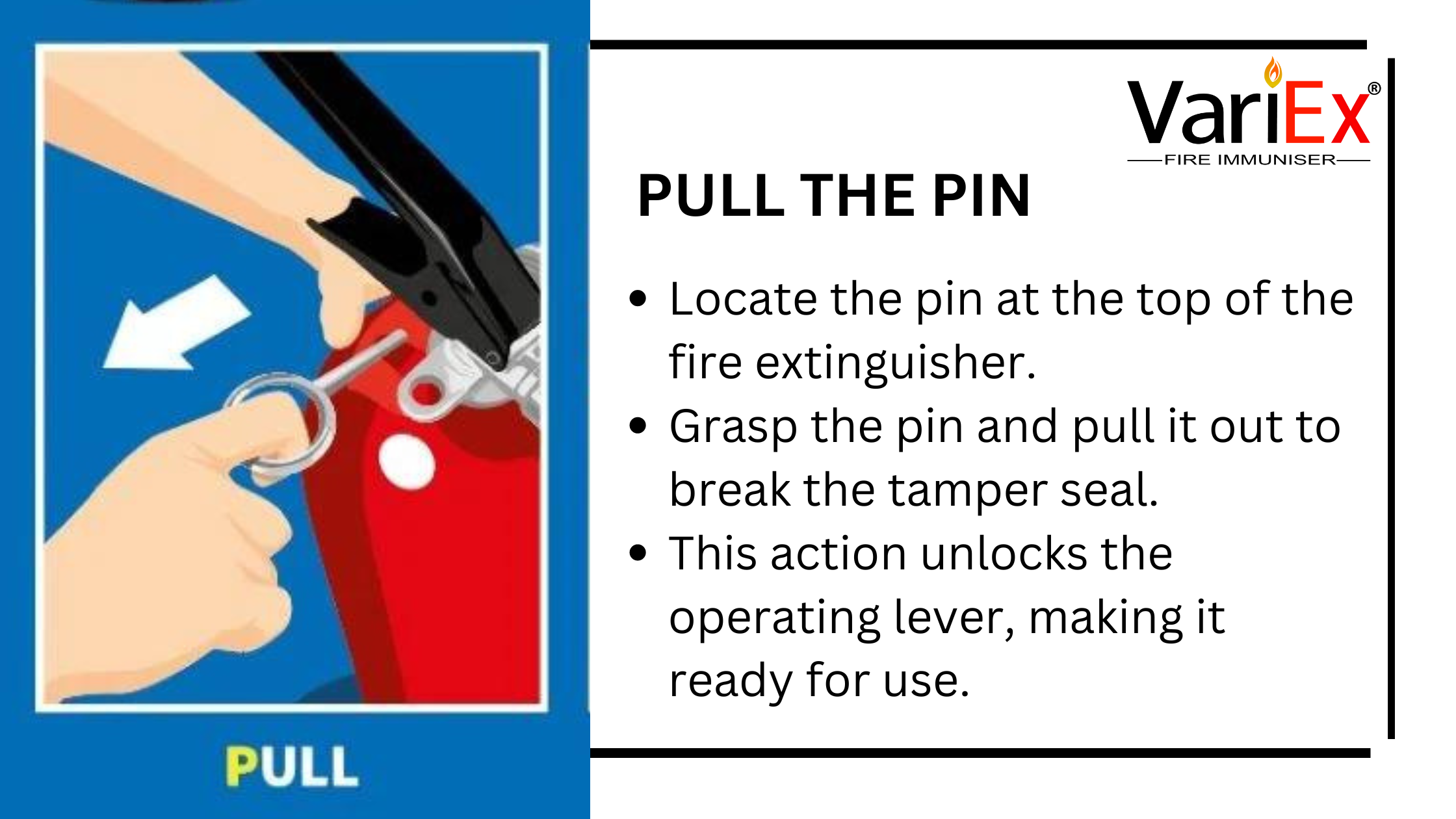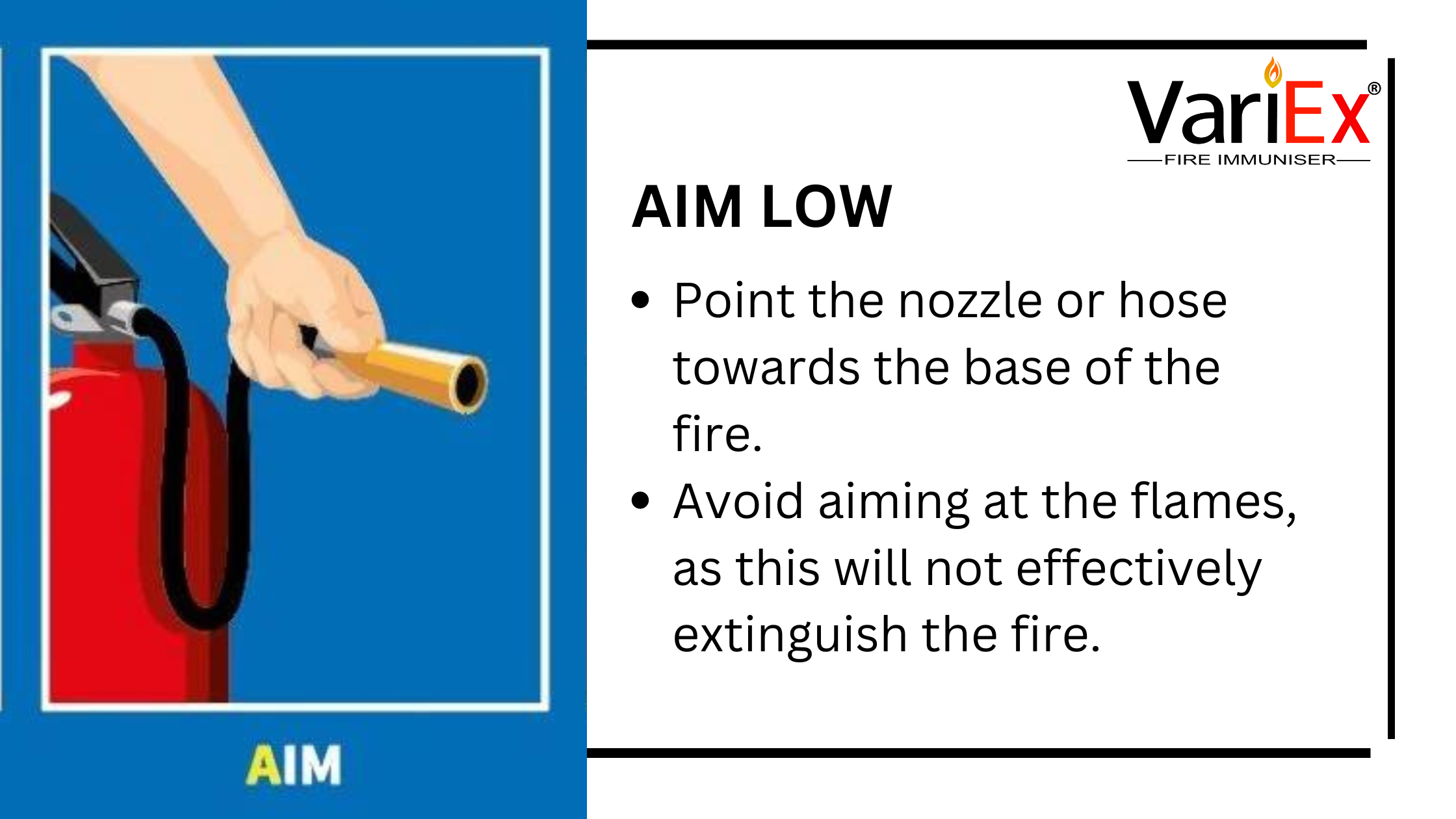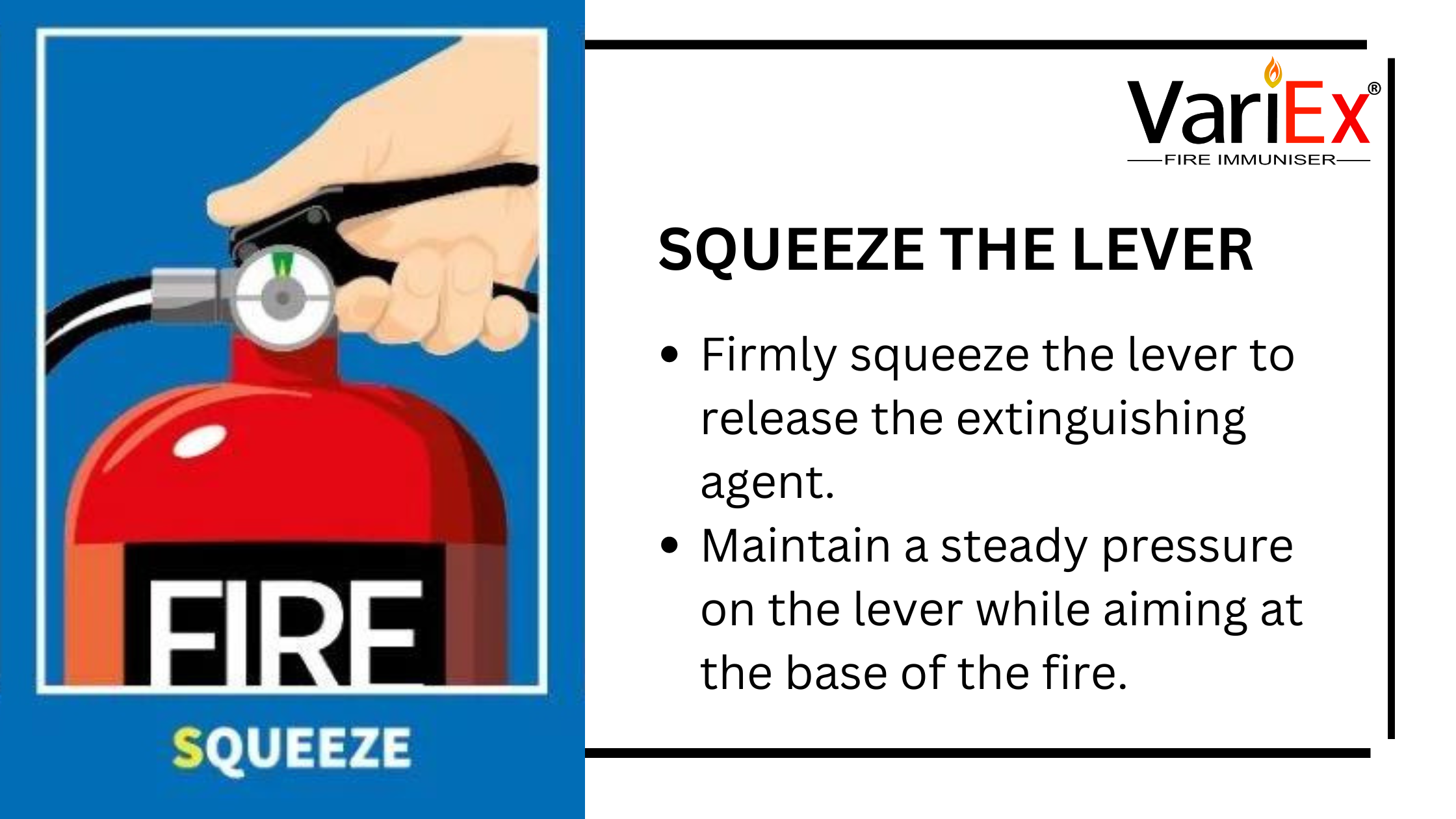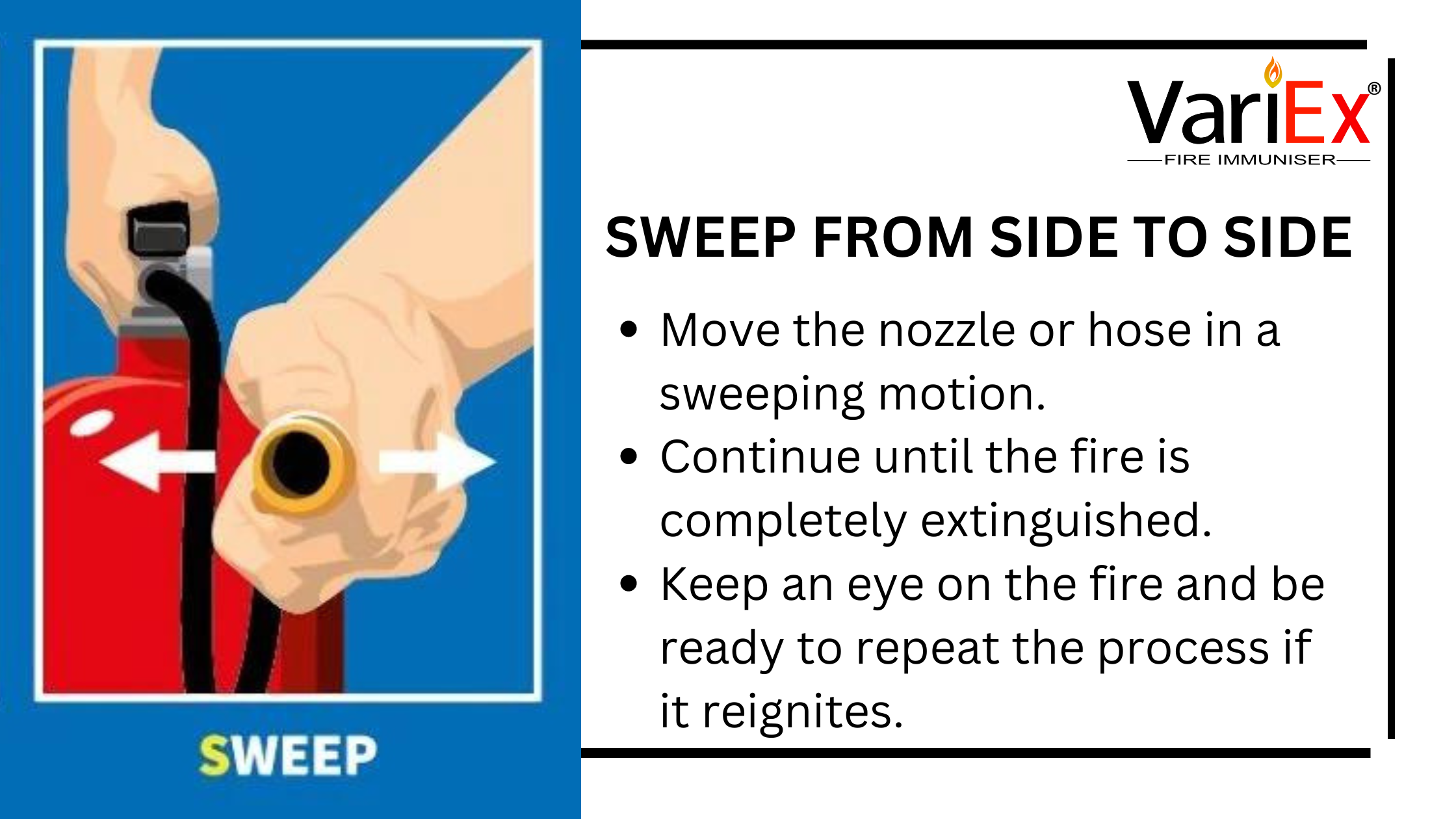![]()
Fire Immuniser
+91-7829629111
Email: info@variex.in
Varistor Technologies Pvt. Ltd.
Block-1, First Floor, Ardente Office One, Hoodi Circle, ITPL Main Road, Bengaluru, Karnataka 560048, IN
How To Use Fire Extinguisher
Fire extinguishers are vital tools for quickly suppressing small fires before they spread and cause significant damage or harm. Understanding how to properly operate a fire extinguisher is essential for everyone's safety. In this comprehensive guide, we'll delve deeper into the specifics of using a fire extinguisher effectively in various situations.
Fire extinguishers are essential safety devices found in homes, workplaces, vehicles, and public buildings. Understanding how to use a fire extinguisher correctly can be the difference between containing a small fire and a disastrous conflagration. This guide provides detailed information on the types of fire extinguishers, the PASS technique, when and how to use them, maintenance, and safety tips.
Understanding Fire Extinguishers
Types of Fire Extinguishers
Fire extinguishers come in various types, each designed to combat specific classes of fires. The main types include:
Water (Class A): Effective against fires involving ordinary combustibles such as wood, paper, and cloth. Not suitable for flammable liquids, electrical fires, or metal fires.
Foam (Class A and B): Suitable for fires involving flammable liquids like gasoline and oil. Also effective on Class A fires. Not recommended for electrical fires.
Carbon Dioxide (Class B and C): Ideal for flammable liquid and electrical fires. CO2 extinguishers displace oxygen to smother the fire. They are not effective on Class A fires.
Dry Chemical (Class A, B, and C): Multi-purpose extinguishers that can handle most types of fires. They interrupt the chemical reaction of the fire triangle.
Wet Chemical (Class K): Specifically designed for kitchen fires involving cooking oils and fats. They cool and form a barrier between the fuel and the oxygen.
Specialized Extinguishers (Class D): Used for metal fires. These extinguishers contain substances like powdered graphite, granular sodium chloride, or copper-based compounds.
Classes of Fires
Understanding the different classes of fires is crucial for selecting the right extinguisher:
- Class A: Fires involving ordinary combustibles like wood, paper, and cloth.
- Class B: Fires involving flammable liquids such as gasoline, oil, and alcohol.
- Class C: Fires involving electrical equipment.
- Class D: Fires involving combustible metals like magnesium and sodium.
- Class K: Fires involving cooking oils and fats.
How To Use Fire Extinguisher: The PASS Technique
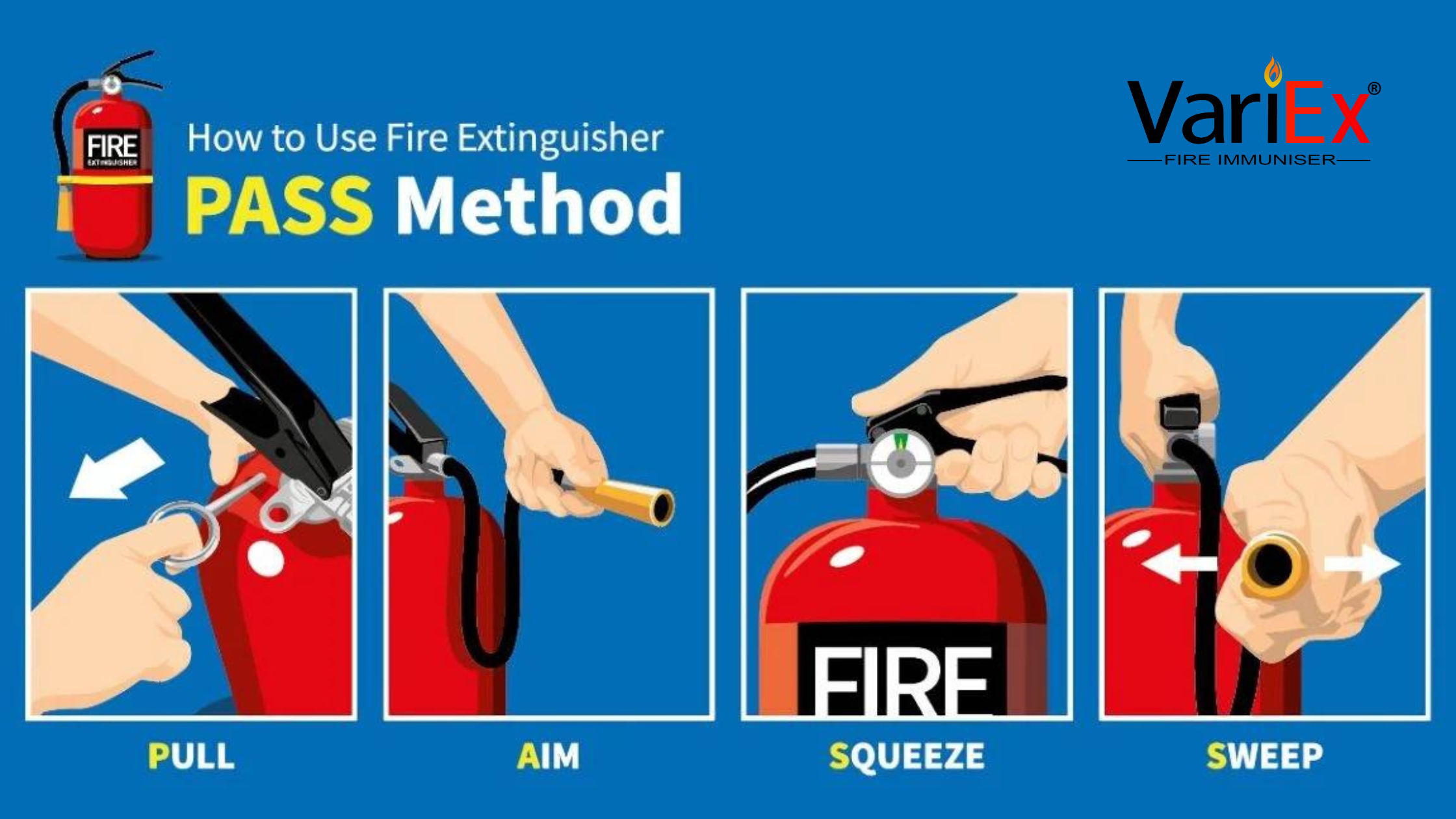
Detailed Steps of the PASS Technique
Step 1: Pull the Pin
The first step in using a fire extinguisher is to pull the pin. The pin is a safety mechanism that prevents accidental discharge of the extinguisher. It is usually located at the top of the extinguisher, near the handle. Here’s how you do it:
- Locate the pin: The pin is typically held in place by a tamper seal, which ensures that the extinguisher has not been used or tampered with.
- Pull the pin: Grasp the pin firmly and pull it out to break the tamper seal. This action unlocks the lever, allowing you to discharge the extinguisher.
Why it's important: Removing the pin is crucial because it enables you to use the extinguisher. Without pulling the pin, you cannot squeeze the lever to release the extinguishing agent.
Step 2: Aim Low
Once the pin is removed, the next step is to aim the nozzle. It’s essential to aim correctly to ensure the effectiveness of the extinguisher. Here’s what you need to do:
- Aim low: Point the nozzle or hose at the base of the fire, not at the flames. Aiming at the base targets the fuel source, which is critical for extinguishing the fire.
- Position yourself: Stand at a safe distance, typically about 6 to 8 feet away from the fire. Ensure you have a clear exit route behind you.
Why it's important: Aiming at the flames will not extinguish the fire. To stop the fire, you need to remove the heat or the fuel source, which is why aiming at the base is crucial.
Step 3: Squeeze the Lever
With the pin removed and the nozzle aimed correctly, you are now ready to discharge the extinguisher. Here’s how to do it:
- Squeeze the lever: Use your dominant hand to firmly squeeze the lever. This action releases the extinguishing agent.
- Apply steady pressure: Maintain a steady pressure on the lever while aiming at the base of the fire. Avoid short bursts; instead, use a continuous stream.
Why it's important: Squeezing the lever allows the extinguishing agent to be expelled from the extinguisher. A continuous and controlled release increases the chances of effectively putting out the fire.
Step 4: Sweep from Side to Side
The final step is to sweep the nozzle from side to side. This ensures the extinguishing agent covers the entire area of the fire. Here’s how to do it:
- Sweep motion: Move the nozzle or hose in a sweeping motion from side to side. Start at the base and work your way upwards if necessary.
- Cover the area: Ensure you cover the entire base of the fire, even if the flames appear to be going out. Continue this motion until the fire is completely extinguished.
Why it's important: Sweeping from side to side allows the extinguishing agent to cover more area, increasing the chances of putting out the fire completely. It also helps prevent the fire from reigniting.
Additional Considerations When Using PASS
Stay Calm and Act Quickly In a fire emergency, staying calm and acting quickly can make a significant difference. Panic can lead to mistakes, so take a deep breath and follow the PASS steps methodically.
Evaluate the Fire Size Assess the size of the fire before using an extinguisher. The PASS technique is effective for small, contained fires. If the fire is too large or spreading rapidly, evacuate immediately and call emergency services.
Use the Correct Extinguisher Ensure you are using the correct type of fire extinguisher for the specific class of fire. Using the wrong extinguisher can be ineffective or even dangerous.
After Extinguishing the Fire Once the fire is out, monitor the area to ensure it does not reignite. If it does, repeat the PASS technique or evacuate if necessary. Always report the incident to the appropriate authorities.
Practice Makes Perfect
Regular Training and Drills Practicing the PASS technique through regular fire extinguisher training and drills can enhance your readiness in a real emergency. Familiarity with the steps and handling the extinguisher boosts confidence and ensures quicker, more efficient responses.
Simulated Scenarios Participate in simulated fire scenarios to practice using the PASS technique in a controlled environment. This hands-on experience reinforces the steps and helps identify any areas for improvement.
When to Use a Fire Extinguisher
Assessing the Situation
Before attempting to use a fire extinguisher, assess the situation:
- Size of the Fire: Only attempt to extinguish small, contained fires. If the fire is large or spreading rapidly, evacuate immediately and call emergency services.
- Evacuation Route: Ensure you have a clear and safe exit path. Never let the fire block your way out.
- Fire Type: Identify the type of fire to select the appropriate extinguisher.
Safety Precautions
- Personal Safety: Ensure your safety first. If in doubt, evacuate and leave firefighting to professionals.
- Electrical Fires: For electrical fires, use a Class C extinguisher or an extinguisher labeled for multiple classes (A, B, C).
- Cooking Fires: For kitchen fires involving oils or fats, use a Class K extinguisher. Do not use water, as it can cause the fire to spread.
When Not to Use a Fire Extinguisher
- Large Fires: Do not attempt to extinguish large or out-of-control fires. Evacuate immediately.
- Toxic Fumes: If the fire involves hazardous materials that produce toxic fumes, evacuate and call emergency services.
- Impaired Judgment: If you are unsure of your ability to use the extinguisher effectively, prioritize evacuation.
Practical Steps for Using a Fire Extinguisher
Preparing the Extinguisher
- Inspect the Extinguisher: Check the pressure gauge to ensure it is in the operational range. Verify the safety seal is intact and the extinguisher is not damaged or expired.
- Stand at a Safe Distance: Position yourself about 6 to 8 feet away from the fire, ensuring you have a clear escape route.
Using the Extinguisher
- Activate the Extinguisher: Pull the pin to unlock the lever.
- Aim the Nozzle: Point the nozzle at the base of the fire.
- Discharge the Extinguisher: Squeeze the lever to release the extinguishing agent.
- Sweep the Nozzle: Move the nozzle in a sweeping motion from side to side.
Post-Use Steps
- Monitor the Fire: Ensure the fire is completely out and does not reignite.
- Evacuate if Necessary: If the fire reignites or cannot be controlled, evacuate immediately.
- Report the Incident: Notify the appropriate authorities or building management about the fire and the use of the extinguisher.
Fire Extinguisher Maintenance
Regular Inspections
- Monthly Checks: Conduct monthly inspections to ensure the extinguisher is accessible, fully charged, and undamaged. Check the pressure gauge, safety seal, and physical condition.
- Annual Maintenance: Arrange for professional inspections and maintenance annually to ensure the extinguisher is in optimal condition.
Recharging and Refilling
- After Use: Refill or recharge the extinguisher immediately after use, even if it is only partially discharged.
- Professional Service: Utilize certified professionals for recharging and refilling to ensure compliance with safety standards.
Replacement
- Expired Extinguishers: Replace extinguishers that are expired or show signs of damage.
- New Extinguishers: Consider upgrading to newer models that offer better performance and ease of use.
Fire Safety and Prevention Tips
Fire Prevention Measures
- Regular Maintenance: Ensure electrical appliances and wiring are in good condition and regularly maintained.
- Safe Storage: Store flammable materials and chemicals safely, away from ignition sources.
- Cooking Safety: Never leave cooking unattended, and keep flammable items away from stovetops.
Fire Safety Plans
- Evacuation Plan: Develop and practice an evacuation plan with all occupants of the building.
- Emergency Contacts: Keep emergency contact numbers readily available.
- Fire Drills: Conduct regular fire drills to ensure everyone knows how to respond in case of a fire.
Education and Training
- Fire Extinguisher Training: Provide training on the proper use of fire extinguishers for all occupants.
- Fire Safety Education: Educate occupants on fire hazards, prevention measures, and emergency response.
Conclusion
Knowing how to use a fire extinguisher effectively is a critical skill that can save lives and property. By understanding the types of fire extinguishers, the PASS technique, and safety precautions, you can be better prepared to respond to a fire emergency. Regular maintenance and training further ensure that you and those around you are equipped to handle fire incidents safely and efficiently. Stay informed, stay prepared, and prioritize safety at all times.
Frequently Asked Questions (FAQs)
PASS is an acronym that stands for Pull, Aim, Squeeze, and Sweep. It represents the four essential steps for operating a fire extinguisher effectively:
- Pull the pin
- Aim low
- Squeeze the lever
- Sweep from side to side
Fire extinguishers are labeled with the classes of fires they can effectively combat. The main classes are:
- Class A: Ordinary combustibles (wood, paper, cloth)
- Class B: Flammable liquids (gasoline, oil)
- Class C: Electrical equipment
- Class D: Combustible metals
- Class K: Cooking oils and fats
Always check the label on the extinguisher to ensure it is suitable for the type of fire you are facing.
No, using the wrong type of fire extinguisher can be dangerous. For example, using a water extinguisher on an electrical fire can cause electrocution, and using it on a grease fire can cause the fire to spread. Always use the appropriate extinguisher for the specific fire class.
Stand about 6 to 8 feet away from the fire. This distance allows you to safely and effectively aim the extinguisher at the base of the fire while maintaining a clear exit route.
- Monthly Inspections: Check the pressure gauge, safety seal, and overall condition of the extinguisher.
- Annual Maintenance: Have a professional inspect and service the extinguisher.
- After Use: Refill or recharge the extinguisher immediately after use, even if only partially discharged.
No, a fire extinguisher should be refilled or recharged after any use, even if it was only partially discharged. This ensures it will be fully effective the next time it is needed.
If the fire reignites, repeat the PASS steps. If the fire continues to spread or cannot be controlled, evacuate immediately and call emergency services.
Yes, but ensure you use a Class K extinguisher specifically designed for kitchen fires involving cooking oils and fats. Never use water on a grease fire, as it can cause the fire to spread.
If the extinguisher does not discharge when the lever is squeezed, check to ensure the pin has been pulled and the nozzle is not obstructed. If it still doesn’t work, evacuate immediately and call emergency services.
While basic understanding and instructions are helpful, it is highly recommended to receive hands-on training in using a fire extinguisher. Familiarity with the PASS technique through training increases your confidence and effectiveness in an emergency.
Final Say
We at VariEx.in or Variexonline.com have mastered the art of designing, installing, inspecting, and fixing automatic sprinkler systems with the help of our in-house team, which is capable of delivering the fire sprinkler services you need, whether large or small and at affordable cost.
To schedule a fire sprinkler installation, or you think our services could benefit your commercial property, contact us online or give us a call at, 7829629111


